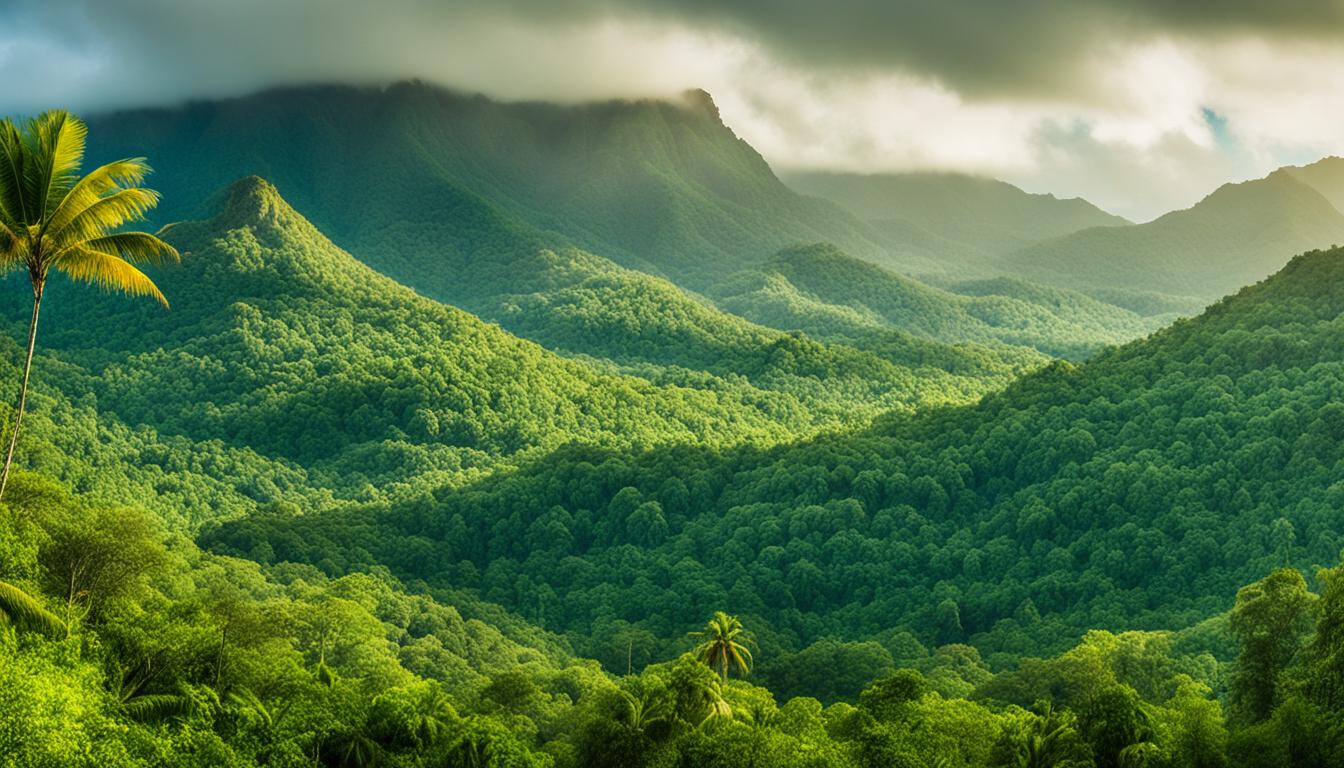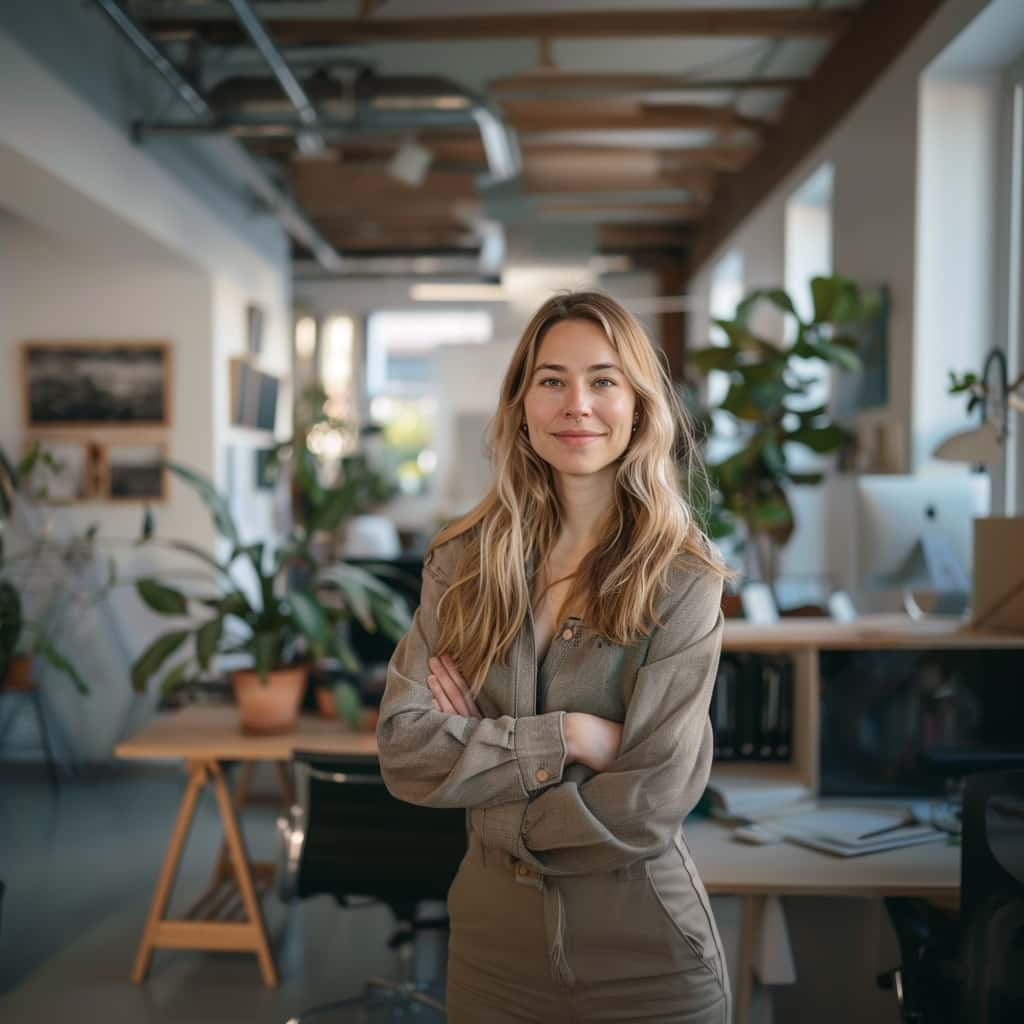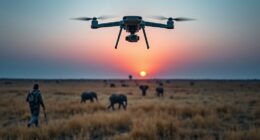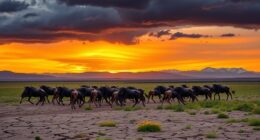Were you aware that Cuba has more than 6,000 known animal species? From colorful birds to mysterious reptiles, this Caribbean island has an impressive level of biodiversity that competes with some of the most famous wildlife destinations worldwide. Discovering the animal kingdom in Cuba is not only an exciting experience; it’s a chance to observe the marvels of nature firsthand.
Key Takeaways:
- Cuba is home to over 6,000 known animal species, making it a biodiversity hotspot.
- Exploring the wildlife in Cuba offers a unique opportunity to witness the wonders of nature.
- Birdwatching, sea turtle nesting, and marine life observation are popular activities in Cuba.
- Cuba’s commitment to environmental conservation ensures the preservation of its pristine landscapes.
- Joining a nature tour in Cuba allows travelers to immerse themselves in the rich natural beauty of the country.
The Pristine Landscapes of Cuba
Cuba is renowned for its pristine landscapes, which encompass a variety of ecosystems ranging from lush rainforests to breathtaking coastal areas. These untouched natural habitats provide a safe haven for a diverse array of wildlife, making Cuba an oasis for nature enthusiasts.
One of the most extraordinary examples of Cuba’s pristine landscapes is the Zapata Peninsula. This UNESCO Biosphere Reserve is a treasure trove of biodiversity, boasting an abundance of bird species, amphibians, and reptiles. As you explore this remarkable peninsula, you’ll be in awe of the thriving wildlife that calls it home.
In addition to the Zapata Peninsula, Cuba offers numerous other protected areas and national parks where you can immerse yourself in the untouched beauty of the island. From the Sierra Maestra mountains to the idyllic beaches of Cayo Coco, each destination brings its own unique charm and pristine landscape.
“Cuba’s pristine landscapes are a testament to the country’s commitment to environmental conservation. By preserving these natural habitats, Cuba offers a unique opportunity for visitors to experience the beauty of wildlife in its purest form.”
Threats to Cuba’s Biodiversity
Despite the richness of Cuba’s biodiversity, economic development poses a significant threat to its unique species. The expansion of industries, urbanization, and deforestation are some of the factors contributing to habitat loss and degradation. As Cuba opens up to the world, there is a critical need to study and conserve its wildlife to prevent further damage to its delicate ecosystems.
Collaborative international research has historically been restricted, limiting the understanding of Cuba’s biodiversity and hindering conservation efforts. However, with increasing global cooperation, there is hope for improved knowledge and conservation practices.
In recent years, researchers and conservation organizations have started recruiting citizen scientists to monitor and document the wildlife in protected areas across Cuba. This approach not only engages the local community but also provides crucial information on the distribution and abundance of species. By actively involving volunteers in data collection, scientists can gather valuable insights to guide conservation efforts effectively.
“The active participation of citizen scientists is invaluable for understanding the threats facing Cuba’s biodiversity and developing proactive conservation strategies,” says Dr. Maria Gomez, a wildlife biologist specializing in Cuban ecosystems.
Conserving Cuba’s biodiversity requires a comprehensive approach that takes into account the unique challenges faced by the country. By studying endangered species, mapping critical habitats, and implementing sustainable practices, researchers and conservationists strive to protect Cuba’s natural heritage for future generations.
While economic development continues to pose threats, increasing awareness and collaboration are essential for preserving Cuba’s diverse wildlife and ensuring a sustainable future.
Threats to Cuba’s Biodiversity:
- Habitat loss and degradation due to expanding industries and urbanization
- Deforestation for agriculture and logging
- Pollution from industrial and human activities
- Climate change and its impacts on ecosystems
- Illegal wildlife trafficking

Wildlife Conservation Efforts in Cuba
Cuba is dedicated to the preservation of its unique wildlife and the conservation of its habitats. Through ongoing research and volunteer efforts, wildlife conservation initiatives are working towards understanding and protecting the diverse species found in Cuba.
One of the primary focuses of wildlife conservation in Cuba is the study of primary pollinators and seed dispersers, such as birds and bats. Scientists are conducting research to better comprehend their vital role in maintaining ecosystem health. By studying their behavior, migration patterns, and population dynamics, these experts can develop effective strategies for preserving both the species and their habitats.
Volunteers play a crucial role in wildlife conservation efforts by assisting with bird and bat population monitoring and documenting endemic and migratory species. Their efforts provide valuable data that helps inform management plans and conservation strategies. By actively engaging citizens in wildlife monitoring and documentation, Cuba is creating a sense of responsibility and ownership among its people, leading to increased awareness and support for conservation efforts.
Overall, the collaborative efforts of scientists and volunteers are vital in protecting Cuba’s unique wildlife and ensuring the long-term sustainability of its ecosystems. By understanding the role each species plays and implementing targeted conservation measures, Cuba is at the forefront of wildlife conservation efforts in the region.
“Conservation is a collective responsibility. By involving citizens and scientists alike, Cuba is fostering a culture where wildlife protection is a shared goal.”
As the efforts continue to grow, the data collected and knowledge gained will contribute to the development of effective conservation policies and management plans. These initiatives will not only benefit Cuba but also serve as a model for wildlife conservation worldwide.

Explore Cuba’s Biodiversity on a Nature Tour
Cuba’s extraordinary biodiversity is best experienced through a nature tour that immerses travelers in the country’s stunning natural landscapes. These tours offer an opportunity to explore UNESCO World Heritage Sites, Biosphere Reserves, dense forests, majestic mountains, and mystical caves. As you embark on a biodiversity tour in Cuba, you’ll discover a world teeming with fascinating wildlife and rich ecosystems.
Immerse Yourself in Cuba’s Natural Beauty
On a Cuba nature tour, you’ll have the chance to witness the incredible diversity of flora and fauna that call this island nation home. Whether it’s the vibrant bird species that fill the air with their melodic songs or the unique marine life that thrives in Cuba’s crystal-clear waters, there is no shortage of natural wonders to explore.
“Cuba’s biodiversity is a treasure trove waiting to be discovered. From its lush rainforests to its pristine coral reefs, each ecosystem offers a unique and awe-inspiring experience.” – Alejandro Morales, Cuban naturalist
Enriching Encounters with Cuban Experts
During your nature tour, you’ll have the opportunity to meet knowledgeable Cuban experts in fields such as permaculture and conservation. They will share their expertise, providing invaluable insights into Cuba’s unique ecosystems and the efforts being made to preserve them. You’ll gain a deeper understanding of the intricate balance between humans and nature, learning how Cuba prioritizes sustainability and environmental conservation.
Indulge in Local Delights
Beyond the captivating wildlife and natural landscapes, a nature tour in Cuba also allows you to immerse yourself in the country’s vibrant culture and culinary traditions. You’ll savor traditional local cuisine, experience the rhythms of Cuban music, and forge connections with the warm and welcoming locals. These cultural experiences will enhance your journey, offering a well-rounded exploration of Cuba’s biodiversity.
Creating Lasting Memories
A Cuba biodiversity tour is more than just an adventure; it’s a transformative experience that will stay with you long after you’ve returned home. The moments spent exploring hidden trails, encountering rare wildlife, and witnessing breathtaking sunsets will become cherished memories. The friendships formed and the knowledge gained from Cuban experts will leave a lasting impact, fueling your passion for conservation and appreciation for the wonders of the natural world.

Embark on a nature tour in Cuba and uncover the extraordinary biodiversity that awaits you. From picturesque landscapes to rare and endemic species, every moment will be a fascinating exploration of nature’s wonders. Discover the hidden gems of Cuba’s natural beauty and create memories that will inspire a lifelong love for the environment.
Accommodation Options in Cuba
When embarking on a nature tour in Cuba, finding the perfect accommodation is essential for a comfortable and authentic experience. Cuba offers a range of accommodation options that cater to different preferences and budgets, ensuring that every traveler can find their ideal place to stay.
1. 4-Star Hotels
If you prefer luxury and modern amenities, there are numerous 4-star hotels available in Cuba. These hotels offer comfortable rooms, excellent service, and facilities such as swimming pools, restaurants, and spas. Staying in a 4-star hotel allows you to relax and unwind after a day of exploring Cuba’s breathtaking biodiversity.
2. Casas Particulares (Private Homestays)
For a more authentic and personalized experience, consider staying in a Casa Particular, which translates to “private house.” Casas Particulares are privately-owned homes that offer guest rooms for tourists. This option allows you to immerse yourself in the local culture, interact with welcoming hosts, and experience traditional Cuban hospitality.
These homestays often provide comfortable accommodations, including private bedrooms and shared common areas. Some Casas Particulares may even offer home-cooked meals, giving you a taste of authentic Cuban cuisine. Staying in a Casa Particular provides a unique opportunity to connect with the local community and gain insights into Cuban life.
3. Ecological Lodges
If you want to be closer to nature and minimize your environmental impact, consider staying in an ecological lodge. These lodges are usually nestled within natural reserves and offer eco-friendly accommodations that blend harmoniously with the surrounding environment.
Ecological lodges provide a tranquil setting and allow you to fully immerse yourself in the beauty of Cuba’s biodiversity. Wake up to the sounds of birds chirping, enjoy breathtaking views, and participate in eco-conscious activities offered by the lodges.
“Staying in a Casa Particular provides a unique opportunity to connect with the local community and gain insights into Cuban life.”
Regardless of your accommodation choice, both 4-star hotels and Casas Particulares offer opportunities to indulge in the unique culture, history, and beauty of Cuba. Choose an option that aligns with your preferences and allows you to experience the warm hospitality that Cuba is known for.
| Accommodation Option | Key Features |
|---|---|
| 4-Star Hotels | Luxury amenities, excellent service, modern facilities |
| Casas Particulares | Authentic experience, personalized interaction with hosts, local charm |
| Ecological Lodges | Eco-friendly accommodations, tranquil setting, close to nature |

Choosing the right accommodation in Cuba enhances your overall nature tour experience, providing you with a comfortable and immersive stay. Whether you prefer the luxuries of a 4-star hotel or the charm of a Casa Particular, Cuba offers an array of options to suit your needs. Book your accommodation today and get ready to embark on an unforgettable adventure through Cuba’s breathtaking biodiversity.
Destinations to Visit in Cuba
When embarking on a Cuba nature tour, travelers are treated to a plethora of breathtaking destinations, each with its own unique charm and allure. From the vibrant streets of Old Havana to the enchanting UNESCO World Heritage Sites and the pristine beauty of the Biosphere Reserves, Cuba offers a diverse range of experiences that cater to every traveler’s preferences.
Old Havana
Step back in time as you wander through the historic streets of Old Havana. This UNESCO World Heritage Site is known for its rich architectural heritage, vibrant colors, and lively atmosphere. Immerse yourself in the sights and sounds of this colonial city, where classic cars line the streets and captivating music fills the air.
UNESCO World Heritage Sites
Explore Cuba’s UNESCO World Heritage Sites, such as Viñales Valley, Trinidad, and Cienfuegos. Marvel at the stunning landscapes of Viñales Valley, with its towering mogotes and vibrant tobacco fields. Wander through the cobblestone streets of Trinidad and admire the well-preserved colonial architecture. Discover the French-inspired elegance of Cienfuegos, often referred to as the “Pearl of the South.”
Biosphere Reserves
Witness the untouched beauty of Cuba’s Biosphere Reserves, including the Ciénaga de Zapata Biosphere Reserve and the Alejandro de Humboldt National Park. The Ciénaga de Zapata Biosphere Reserve is a haven for birdwatchers and nature enthusiasts, with its extensive wetlands and diverse bird species. The Alejandro de Humboldt National Park, recognized as a UNESCO World Heritage Site, is home to unique flora and fauna, including the Cuban solenodon and the Cuban ivory-billed woodpecker.
Whether you prefer to immerse yourself in the historical charm of Old Havana, explore the captivating UNESCO World Heritage Sites, or discover the untouched beauty of the Biosphere Reserves, Cuba offers a wide range of destinations that promise to leave you in awe.
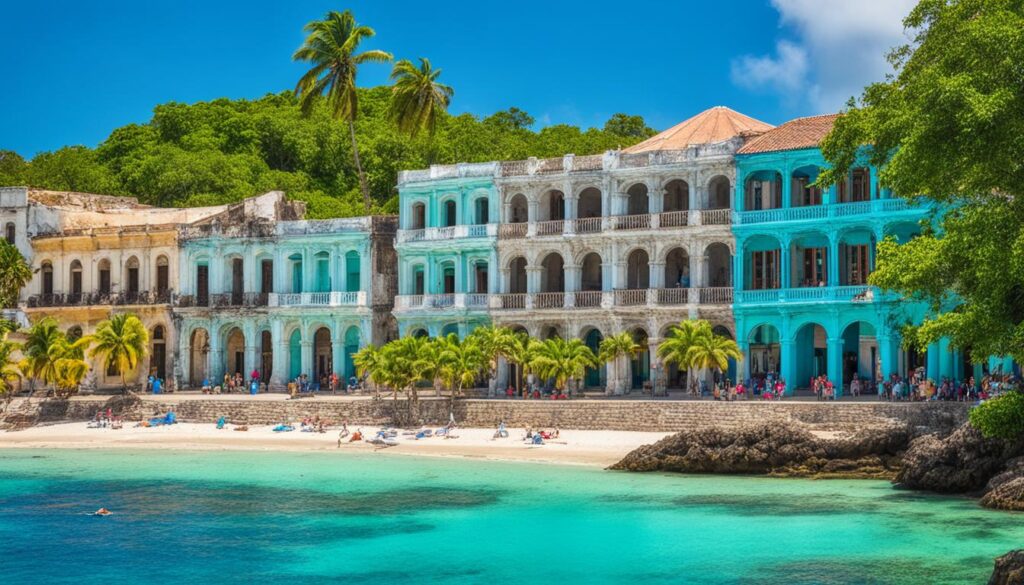
Travel Restrictions for Americans
Travel to Cuba from the United States is subject to certain restrictions under US Cuba travel regulations. However, Americans still have opportunities to visit Cuba for educational and cultural exchanges. These experiences must be included in their itineraries to comply with the regulations.
Authorized US organizations can assist Americans in organizing their travel to Cuba. These organizations have the necessary knowledge and expertise to ensure compliance with the specific guidelines set forth by the US government.
Americans Traveling to Cuba for Educational and Cultural Exchanges
While tourism to Cuba from the US is prohibited, Americans can still visit the country for educational and cultural exchanges. These exchanges provide a valuable opportunity for Americans to immerse themselves in Cuban culture, history, and way of life.
By participating in educational and cultural exchanges, Americans can gain a deeper understanding and appreciation for Cuban society while fostering cross-cultural connections. These experiences offer a unique perspective on Cuba’s rich heritage, arts, and traditions.
“Travel to Cuba can be a transformative experience, allowing Americans to engage with the vibrant Cuban community, experience their hospitality, and learn from their unique perspective.”
Organizing Travel to Cuba through Authorized US Organizations
Travel to Cuba for Americans must be arranged through authorized US organizations. These organizations have the knowledge and expertise to navigate the complexities of US Cuba travel regulations and ensure compliance.
By working with authorized organizations, Americans can enjoy a hassle-free travel experience, with all necessary paperwork and documentation taken care of. These organizations can help plan itineraries that include educational and cultural activities, maximizing the immersive experience in Cuba.
Additionally, authorized organizations have established relationships with Cuban counterparts, ensuring access to the best educational and cultural opportunities during the visit.
Compliance with Specific Guidelines for Travel to Cuba
It is essential for Americans traveling to Cuba to comply with the specific guidelines set forth by the US government. These guidelines outline the permissible purposes for travel and the necessary documentation to be obtained.
Travelers are advised to consult with authorized US organizations to ensure that they meet all the requirements. These organizations can provide the most up-to-date information on the regulations and assist travelers in obtaining the necessary licenses and permits.
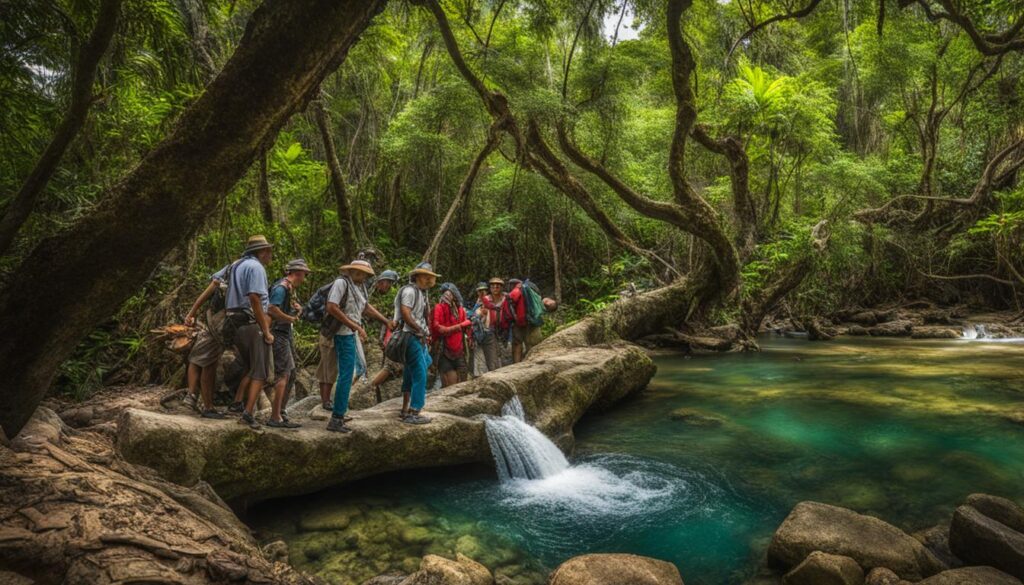
Join a Nature Tour as a US Educational Institution
US educational institutions, including universities and colleges, have the unique opportunity to organize and sponsor educational trips to Cuba. These nature tours provide a valuable learning experience for students, faculty, and staff, allowing them to immerse themselves in the rich biodiversity and cultural heritage of Cuba.
By joining a nature tour in Cuba, educational institutions can offer structured educational programs that combine classroom learning with hands-on field experiences. Students can engage in wildlife research, participate in conservation activities, and learn about sustainable practices firsthand.
Furthermore, these educational trips foster cultural exchanges, promoting a deeper understanding and appreciation of Cuban traditions, history, and way of life. Students will have the chance to interact with local communities, learn from Cuban experts in permaculture and conservation, and gain a global perspective on environmental issues.
Key Benefits of Joining a Nature Tour:
- Structured Educational Programs: Educational institutions can design customized itineraries that align with their academic goals and objectives, ensuring a well-rounded educational experience for participants.
- Cultural Exchanges: Students can engage with locals, building connections and fostering cross-cultural understanding.
- Research Opportunities: Nature tours in Cuba provide a unique platform for research collaboration, facilitating scientific studies on biodiversity conservation and sustainable practices.
- Experiential Learning: Participants can gain practical skills and knowledge through hands-on activities, such as wildlife observation, data collection, and environmental restoration projects.
- Community Engagement: By supporting local communities and sustainable tourism initiatives in Cuba, educational institutions contribute to the socio-economic development of the region.
It is important to note that compliance with the Office of Foreign Assets Control (OFAC) guidelines is necessary when organizing educational trips to Cuba. Authorized travel providers, like Authentic Cuba Travel, can assist in navigating the legal requirements and ensuring a smooth and compliant travel experience.
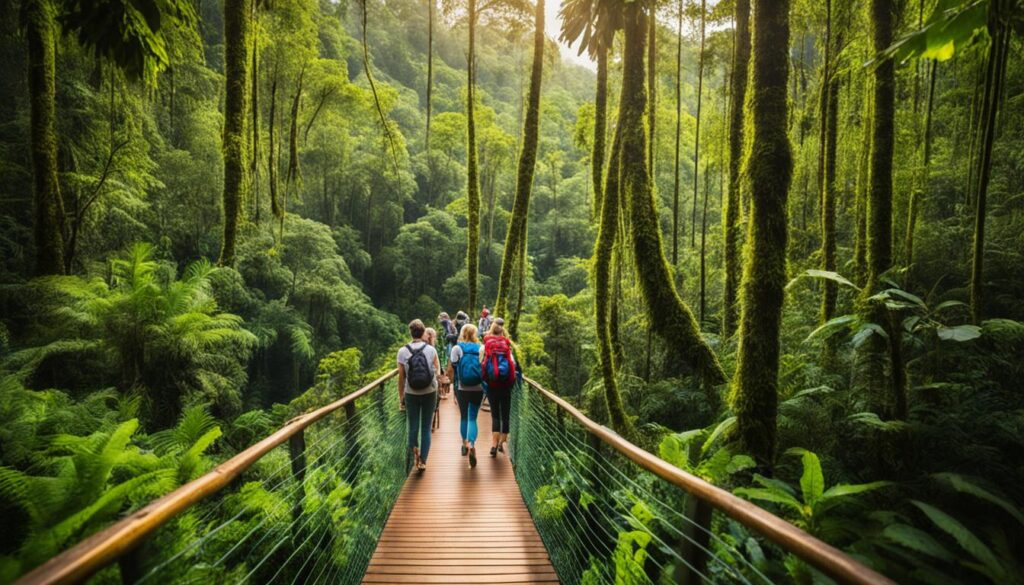
Testimonial:
“Our university’s nature tour in Cuba was an incredible experience for our students. They were able to witness the unique biodiversity of Cuba, learn from local experts, and contribute to conservation efforts. The cultural exchanges and research opportunities enriched their understanding of environmental issues and fostered global citizenship.”
– Dr. Emily Thompson, Professor of Ecology, University of XYZ
Join a Nature Tour as a US Wildlife Organization
US wildlife organizations have the opportunity to organize and participate in nature tours in Cuba, benefiting from the General License for Educational Activities. These tours provide an avenue for wildlife researchers, bird conservancy organizations, and environmental organizations to engage in educational activities, conduct professional research, and contribute to nature conservation efforts.
Engage in Educational Activities
By joining a nature tour in Cuba, US wildlife organizations can participate in educational activities that promote knowledge sharing and learning. Expert guides and local experts provide valuable insights into Cuba’s unique biodiversity, conservation practices, and sustainable initiatives. Through workshops, presentations, and field excursions, wildlife organizations can broaden their understanding of Cuban ecosystems and gain new perspectives on conservation strategies.
Conduct Professional Research
One of the key advantages of joining a nature tour as a US wildlife organization is the opportunity to conduct professional research in collaboration with Cuban experts. By exploring diverse habitats, studying local species, and collecting data, wildlife organizations can contribute to scientific research and contribute to conservation efforts. The exchange of knowledge and expertise between US and Cuban researchers fosters a global approach to wildlife conservation.
Contribute to Nature Conservation Efforts
Participation in a nature tour allows US wildlife organizations to actively contribute to nature conservation efforts in Cuba. By sharing their experiences, best practices, and innovative approaches, organizations can collaborate with Cuban counterparts to develop sustainable conservation strategies. Through fieldwork, data collection, and engagement with local communities, wildlife organizations play a vital role in protecting Cuba’s unique wildlife and their habitats.
List of US Wildlife Organizations Engaging in Nature Tours in Cuba
| Organization | Description |
|---|---|
| National Audubon Society | Leading bird conservation organization focused on protecting birds and their habitats through science, advocacy, and education. |
| Center for Biodiversity and Conservation | International conservation organization that advances scientific research and fosters partnerships to safeguard biodiversity. |
| Defenders of Wildlife | Non-profit organization committed to protecting endangered species and habitats in North America and around the world. |
| Conservation International | Global organization dedicated to protecting nature and promoting sustainable development to benefit both people and the planet. |
Joining a nature tour in Cuba as a US wildlife organization not only provides an enriching experience but also contributes to the collective effort of conserving precious wildlife and their habitats. Together, these organizations can make a significant impact and foster long-term partnerships for the benefit of biodiversity in Cuba and beyond.

Authentic Cuba Travel’s Nature Tours
Experience the wonders of Cuba’s biodiversity with Authentic Cuba Travel’s nature tours. These immersive tours are specially designed to explore the country’s rich natural landscapes and engage in cross-cultural experiences. Led by expert guides in environmental conservation, our nature tours provide unique insights into Cuba’s stunning beauty and sustainable practices.
At Authentic Cuba Travel, we understand the importance of preserving and protecting Cuba’s unique ecosystems. Our nature tours focus on sustainable travel, ensuring minimal impact on the environment while offering an unforgettable experience.
During our nature tours, you’ll have the opportunity to:
- Explore diverse ecosystems, including rainforests, coastal wetlands, and coral reefs.
- Observe an array of wildlife, from rare bird species to nesting sea turtles.
- Learn from local experts in permaculture and environmental conservation.
- Immerse yourself in Cuban culture, enjoying traditional food, music, and camaraderie.
Our expert guides will take you to the most biodiverse areas of Cuba, including UNESCO World Heritage Sites and Biosphere Reserves. You’ll witness the country’s commitment to wildlife preservation and gain a deeper understanding of its fragile ecosystems.
Authentic Cuba Travel is dedicated to providing exceptional, educational experiences while promoting sustainable and responsible tourism. Our nature tours offer a unique blend of adventure, education, and cultural immersion that will leave you with lasting memories.
Ready to embark on an unforgettable journey through Cuba’s natural wonders? Join Authentic Cuba Travel’s nature tours and discover the remarkable biodiversity that makes Cuba a truly extraordinary destination.
| Tour | Duration | Highlights |
|---|---|---|
| Nature’s Haven | 7 days | – Exploring the Zapata Peninsula, a UNESCO Biosphere Reserve – Birdwatching in the lush rainforests – Snorkeling in vibrant coral reefs |
| Coastal Treasures | 10 days | – Visiting the breathtaking beaches of Varadero and Trinidad – Experiencing the nesting rituals of sea turtles – Discovering the vibrant marine life in Cuba’s coastal waters |
| Wildlife Expedition | 14 days | – Exploring the remote areas of Sierra Maestra and Topes de Collantes – Tracking elusive Cuban crocodiles – Observing endemic bird species in their natural habitats |

Discover Cuba’s Unique Wildlife
Cuba boasts a remarkable array of unique wildlife, making it a paradise for nature enthusiasts. From elusive Cuban crocodiles and delicate miniature birds and frogs to mesmerizing migrating land crabs, Cuba’s wildlife is as diverse as it is captivating.
Exploring the protected areas and national parks of Cuba provides an unparalleled opportunity to witness these fascinating creatures in their natural habitats. Whether you’re hiking through lush rainforests, diving into vibrant coral reefs, or traversing coastal wetlands, Cuba’s extraordinary wildlife never fails to leave a lasting impression.
One of Cuba’s iconic wildlife species is the Cuban crocodile (Crocodylus rhombifer), found only in this Caribbean island nation. With its distinctive snout and striking yellow markings, this endangered reptile is a true testament to Cuba’s unique biodiversity.
Another captivating highlight of Cuba’s wildlife is the world’s smallest bird, the Bee Hummingbird. Weighing in at just 2.6 grams, this tiny hummingbird is a sight to behold with its iridescent feathers and dazzling aerial acrobatics amidst Cuba’s lush flora.
Cuba also boasts the world’s smallest frog, the Monte Iberia Eleuth (Eleutherodactylus iberia). This diminutive amphibian measures a mere 9.8 millimeters and is endemic to Cuba’s Sierra de los Órganos mountain range. Its minuscule size and vibrant coloration make it a highly sought-after sighting for wildlife enthusiasts.
“Cuba’s wildlife is a treasure trove of rare and distinctive species, reflecting the country’s unique ecosystems and commitment to conservation. From its endemic species to charismatic migrants, Cuba offers an unforgettable wildlife experience for all nature lovers.” – Dr. María García, Wildlife Researcher
One of the most spectacular natural phenomena in Cuba is the migration of land crabs. Every year, millions of land crabs embark on a remarkable journey from the island’s forests to the sea, painting the landscape red with their vibrant colors. This incredible spectacle showcases the resilience and adaptability of Cuba’s wildlife.
To fully immerse yourself in the wonders of Cuba’s unique wildlife, embark on a nature tour that takes you into the heart of its protected areas and national parks. Experienced guides and local experts will lead you on unforgettable adventures, providing insights into the intricate ecosystems and the remarkable species that inhabit them.
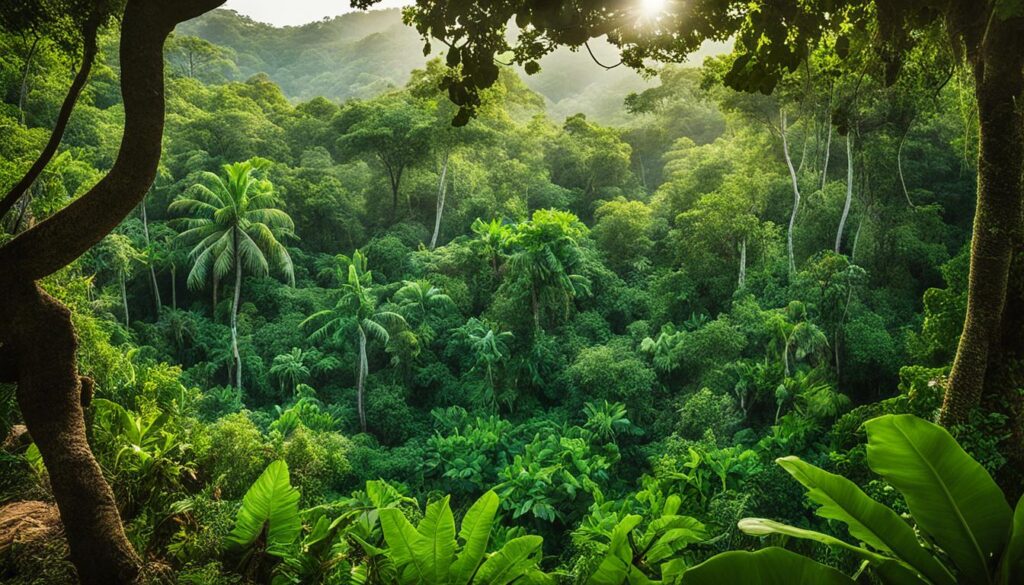
Sustainable Practices in Cuba
In spite of being a relatively poor country, Cuba has demonstrated a strong commitment to sustainability through its self-sustainable practices. This commitment is reflected in various aspects of Cuban society, from agriculture to education and healthcare. Through these sustainable practices, Cuba has managed to make significant contributions to environmental friendliness and conservation.
Agricultural Self-Sufficiency
One remarkable example of Cuba’s sustainable practices is its agricultural self-sufficiency. Due to historical circumstances, such as the trade embargo, Cuba has had to rely on its own resources for food production. This has led to the development of innovative agricultural techniques, including organic and urban farming. By reducing the reliance on imported goods, Cuba has not only improved its food security but also minimized the environmental impact associated with long-distance transportation.
Renewable Energy Sources
Cuba has also made significant strides in harnessing renewable energy sources, further highlighting its commitment to sustainability. The country has been investing in wind, solar, and biomass energy, reducing its dependence on fossil fuels. This transition to renewable energy has both environmental and economic benefits, paving the way for a greener and more sustainable future for Cuba.
Education and Scientific Research
Cuba’s dedication to sustainability is further evident in its emphasis on education and scientific research. Despite its economic challenges, Cuba has managed to produce a high percentage of scientists in Latin America. This investment in education and research has contributed to the country’s ability to develop sustainable practices and find innovative solutions to environmental issues.
Citizen Participation and Environmental Awareness
Cuba recognizes the importance of citizen participation and environmental awareness in achieving sustainable development. The government actively promotes environmental education and encourages citizen involvement in conservation efforts. Through initiatives like community-based reforestation projects, waste management programs, and eco-tourism, Cuba is fostering a sense of responsibility towards the environment among its citizens.
| Sustainable Practices in Cuba | Benefits |
|---|---|
| Agricultural Self-Sufficiency | – Improved food security – Reduced environmental impact |
| Renewable Energy Sources | – Reduced dependence on fossil fuels – Economic and environmental benefits |
| Education and Scientific Research | – Development of innovative solutions – Contribution to sustainable practices |
| Citizen Participation and Environmental Awareness | – Fostering a sense of responsibility – Conservation and community engagement |
By incorporating sustainable practices into various aspects of its society, Cuba is setting an exemplary model for others to follow. Its self-sufficiency, renewable energy efforts, investment in education and research, and citizen participation demonstrate a genuine commitment to environmental preservation and a sustainable future.
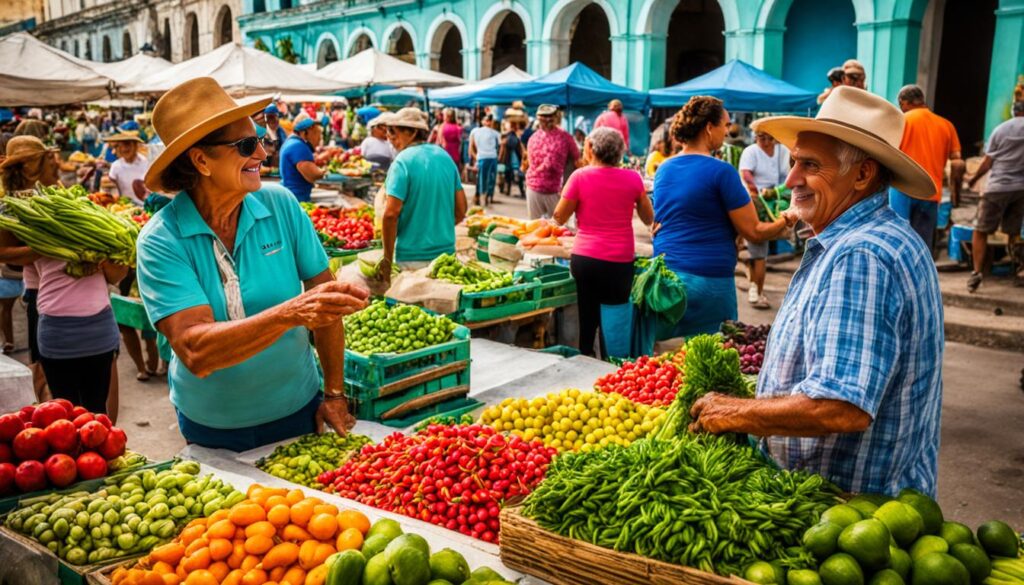
Plan Your Cuba Nature Tour Itinerary
Planning a Cuba nature tour itinerary involves careful consideration of your interests and goals. To make the most of your trip, select destinations, accommodations, and activities that align with your preferences. Here are some key factors to consider when planning your Cuba nature tour:
Destinations:
Cuba is home to diverse ecosystems, each offering unique wildlife and landscapes. Research the different regions of Cuba and identify the areas that interest you the most. Whether it’s exploring the lush rainforests, coastal wetlands, or vibrant coral reefs, choose destinations that align with your nature and wildlife preferences.
Accommodations:
Consider the type of accommodations that best suit your requirements. Cuba offers a range of options, from luxury hotels to private homestays known as Casas Particulares. Stay in comfortable surroundings that allow you to relax and rejuvenate after a day spent exploring nature.
Activities:
Think about the specific wildlife you want to observe and the experiences you wish to have during your Cuba nature tour. Identify activities such as birdwatching, snorkeling, hiking, or wildlife photography that align with your interests. Engaging in these activities will enhance your overall experience and create lasting memories.
Duration:
Consider the duration of your trip when planning your itinerary. Determine how many days you have available and allocate time for each destination and activity accordingly. This will help you make the most of your Cuba nature tour and ensure you have ample time to explore each location.
Tour Operator:
Working with a reputable tour operator like Authentic Cuba Travel can greatly enhance your experience. Their expertise in planning nature tours in Cuba ensures that your itinerary is well-structured, maximizing your opportunities to observe wildlife and immerse yourself in the country’s natural beauty.
By carefully planning your Cuba nature tour itinerary, you can ensure a well-rounded and fulfilling trip that allows you to explore the country’s rich biodiversity, engage in exciting activities, and create lasting memories.

Traveling to Cuba from the US
When it comes to traveling to Cuba from the US, there are specific regulations and guidelines that must be followed. As an American traveler, it is important to stay updated on the latest travel restrictions and requirements.
Authorized US organizations can assist in arranging flights and visa arrangements either through US ports or third countries. These organizations have the knowledge and experience to navigate the necessary paperwork and ensure compliance with the regulations set out by both the US and Cuban governments.
Flight and Visa Arrangements
Authorized US organizations can facilitate flight and visa arrangements for travelers heading to Cuba. Flights may be arranged from US airports that have been granted permission for direct travel, or they may be organized through third countries, such as Canada or Mexico. The organizations will handle the necessary logistics, ensuring a smooth and hassle-free journey.
Visa arrangements are essential for entry into Cuba. Depending on the purpose of your trip, different types of visas may apply. US organizations will assist in obtaining the appropriate visa and guide you through the necessary steps to ensure compliance with Cuban immigration requirements.
Staying Updated on Travel Restrictions
Given the evolving nature of travel restrictions, it is crucial to stay informed about any changes that may occur. The US Department of State and Treasury Department’s Office of Foreign Assets Control (OFAC) are reliable sources for up-to-date information on travel restrictions and guidelines for Americans traveling to Cuba.
“It is imperative for travelers to keep themselves informed about the latest travel restrictions and requirements when planning a trip to Cuba. By staying updated on the regulations, you can ensure a smooth and lawful travel experience.”
Conclusion
Cuba’s rich biodiversity, pristine landscapes, and commitment to wildlife conservation make it an exceptional destination for nature enthusiasts. With its diverse ecosystems encompassing rainforests, coastal wetlands, and coral reefs, Cuba is a haven for a wide variety of wildlife. From birdwatching to observing nesting sea turtles and marine life, travelers can immerse themselves in the country’s unique biodiversity on a Cuba nature tour.
By participating in a Cuba nature tour, travelers not only have the opportunity to discover and appreciate the country’s unique wildlife but also engage in cross-cultural experiences. They can explore UNESCO World Heritage Sites, Biosphere Reserves, and other natural landscapes, while also learning from Cuban experts in permaculture and conservation. Additionally, travelers can indulge in traditional local food, music, and camaraderie, enhancing their overall experience.
Moreover, participating in a Cuba nature tour allows travelers to contribute to the preservation of these invaluable ecosystems. Cuba’s commitment to wildlife conservation is exemplified through ongoing research, monitoring, and the active involvement of citizen scientists. By supporting these efforts, travelers can play a role in the long-term sustainability of Cuba’s rich biodiversity and help protect the habitats of its unique species.
